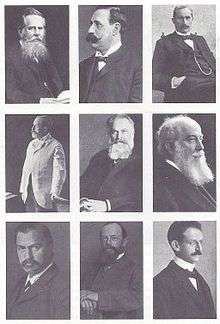Bernhard Bardenheuer
Bernhard Bardenheuer (July 12, 1839, Lamersdorf – August 13, 1913) was a German surgeon.
In 1864 he received his doctorate from Berlin, where he studied under Bernhard von Langenbeck (1810-1887). In 1865 he began work as an assistant to Karl Busch (1826-1881) at the surgical clinic at the University of Bonn, afterwards relocating to Heidelberg, where he worked under ophthalmologist Otto Becker (1828-1893) and surgeon Gustav Simon (1824-1876). During the Franco-Prussian War he served in a sick bay at a garrison in Heidelberg.
From 1872 he was a hospital surgeon in Köln, where in 1875 he introduced Listerian antisepsis. In 1884 he received the title of professor, even though he was not a member on any university's academic staff.

Bardenheuer specialized in genitourinary surgery, and in 1887 performed the first complete cystectomy. This operation involved a patient who was suffering from an advanced bladder tumour that affected both ureters. The patient died two weeks after the surgery from uremia and hydronephrosis — nevertheless, Bardenheuer was able to prove the technical workability of the surgery. In 1889 Austrian gynecologist Karl Pawlik performed a successful cystectomy on a patient suffering from papillomatosis of the bladder.[1]
In 1909 he performed an autogenous bone graft of the mandible, a procedure that involved replacement of a mandibular condyle with a patient's 4th metatarsal.[2] The "Bardenheuer incision" is named after him, which is a surgical incision used for operative treatment of mastitis. In German medical literature it is referred to as Bardenheuer-Schnitt (Bardenheuer cut) or Bardenheuer-Bogenschnitt (Bardenheuer arc cut).[3][4]
Selected publications
- Der extraperitoneale Explorativschnitt. Die differentielle Diagnostik der chirurgischen Erkrankungen und Neubildungen des Abdomens, 1887
- Die permanente Extensionsbehandlung : die subcutanen und complicirten Fracturen und Lyxationen der Extremitäten und ihre Folgen, 1889; (The permanent extension treatment: subcutaneous and compound fractures of the extremities and luxations and their consequences).
- Die allgemeine Lehre von den Frakturen und Luxationen mit besonderer Berücksichtigung der Extensionsverfahren (1907); (The general theory of fractures and dislocations, with special consideration given to the extension process).
- Die Technik der Extensionsverbände bei der Behandlung der Frakturen und Luxationen der Extremitäten (published with Rudolf Graessner (1867-1927); (The technique of extension associations in the treatment of fractures and dislocations of the extremities), translated into French and English- 5th edition, 1918)
References
- Bernhard Bardeheuer @ Who Named It
- Bernhard Bardenheuer at Who Named It
- Oral And Maxillofacial Surgery By Raymond J. Fonseca, Robert A Bays
- "Archived copy". Archived from the original on 2011-08-25. Retrieved 2011-12-23.CS1 maint: archived copy as title (link) Med-forum.eu
- Medizin-lexicon